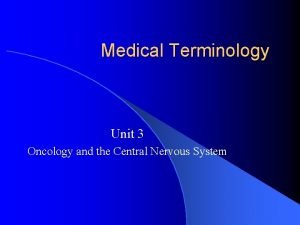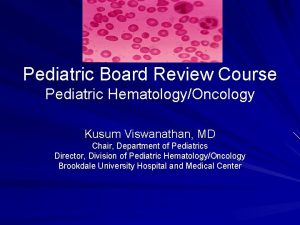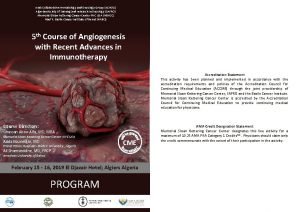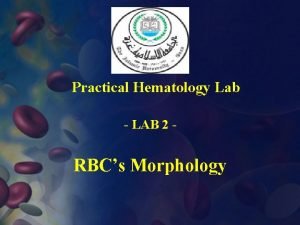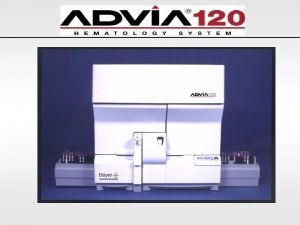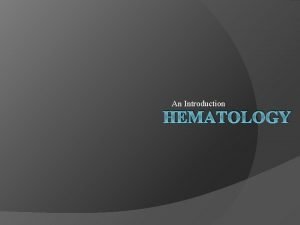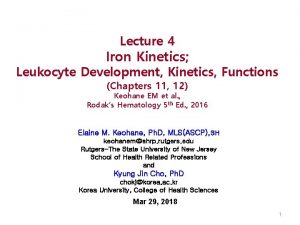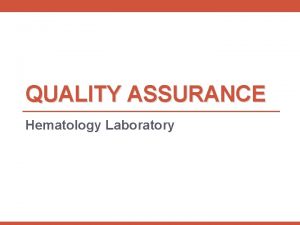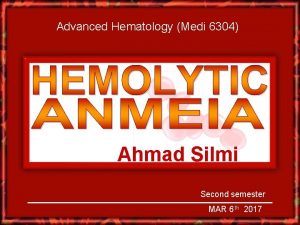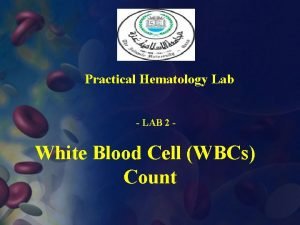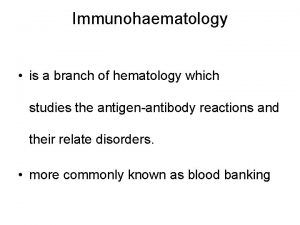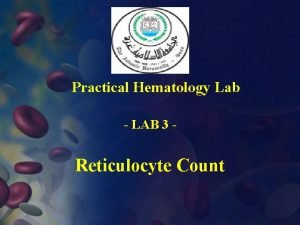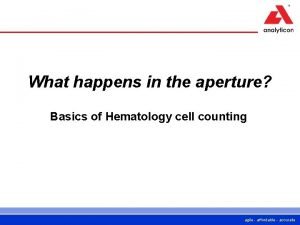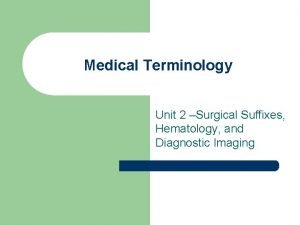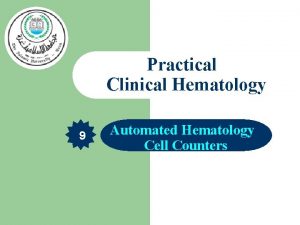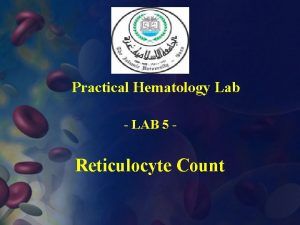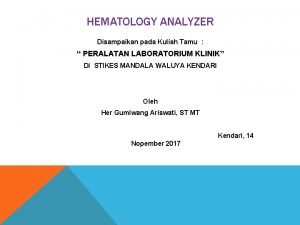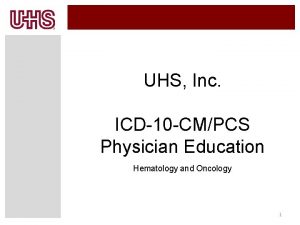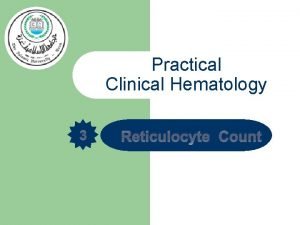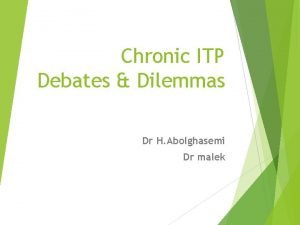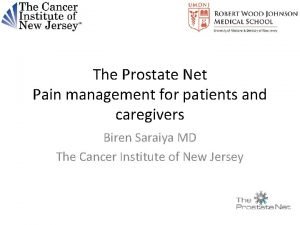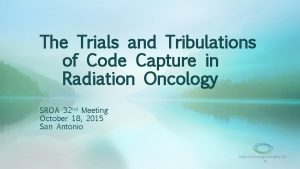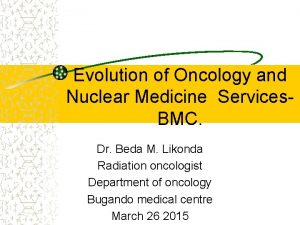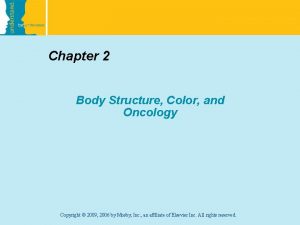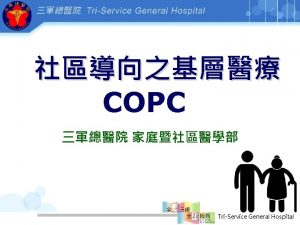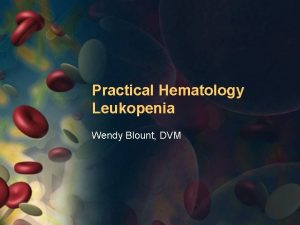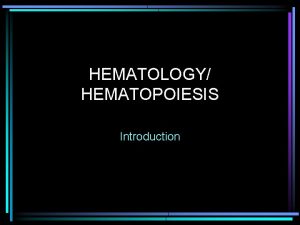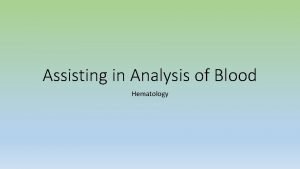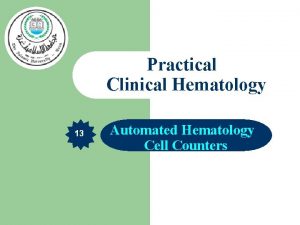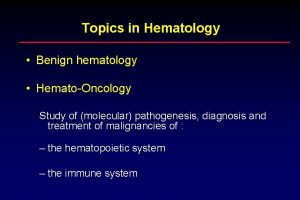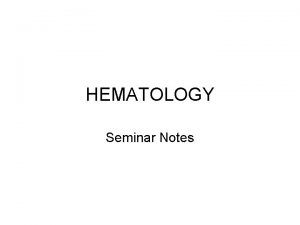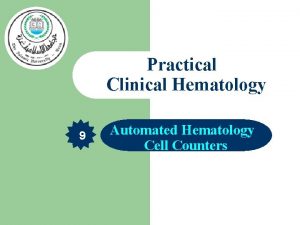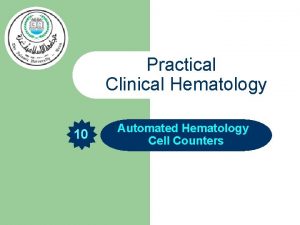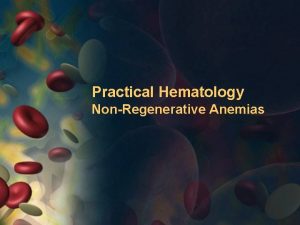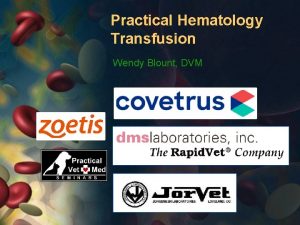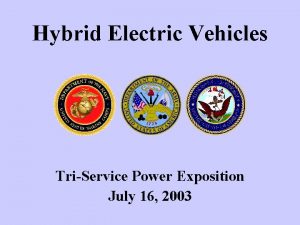Hematology Oncology Division of Hematology Oncology TriService General
















































- Slides: 48

Hematology & Oncology 何景良 Division of Hematology /Oncology Tri-Service General Hospital National Defense Medical Center 1

Hematology 2

Hematopoiesis Formation of blood cells Occurs mostly in red bone marrow All cells arise from same blood stem cell (pluripotent hematopoietic stem cells) Recently some have been found in adults which are mesenchymal stem cells, which can also form fat cells, osteoblasts, chondrocytes, fibroblasts and muscle cells 3

Blood stem cells divide into: 1. myeloid stem cells or 2. lymphoid stem cells All except for lymphocytes arise from myeloid stem cells All originate in the bone marrow Not shown are mast cells, osteoclasts, dendritic cells 4

CBC is probably commonest test done (“complete blood count”-how much of each type of cell) Hemoglobin (gm/dl) usually 15 Hematocrit (%) RBC count WBC in thousands/cumm Differential if ordered: broken down to amount of each type WBC Platelet count in thousands/cumm 5

Erythrocytes Also called RBCs or red blood cells Biconcave discs and flexible Plasma membrane but no nuclei or organelles Packed with hemoglobin molecules Oxygen carrying protein 4 chains of amino acids, each with iron which is binding site for heme oxygen; CO 2 carried also Young ones still containing ribosomes are called reticulocytes Live 100 -120 days iron atom 6

Leukocytes WBCs: white blood cells 7

__RBC Leukocytes neutrophil eosinophil WBCs: white blood cells basophil Note the size difference compared to erythrocytes small lymphocyte monocyte 8

Leukocyte types Artificial division into granulocytes and agranulocytes Granulocytes: neutrophils, eosinophils, basophils (according to how stain) Granules Lobed nuclei All are phagocytic Agranulocytes: lymphocytes, monocytes 9

Neutrophils 60% of all WBCs Nuclei of 2 -6 lobes Other names: Polymorphonuclear cells (PMNs, polys, segs) Granules have enzymes Can damage tissue if severe or prolonged Pus 10

Eosinophils 1 -4 % of leukocytes Bilobed Granules have digestive enzymes Role in ending allergic reactions and in fighting parasitic infections 11

Basophils Rarest WBC Bilobed nucleus Dark purple granules Later stages of reaction to allergies and parasitic infections 12

Lymphocytes* * Most important WBC 20 -45% Most are enmeshed in lymphoid connective tissue, e. g. lymph nodes, tonsils, spleen 13

Lymphocytes: nucleus occupies most of the cell volume Response to antigens (foreign proteins or parts of cells) is specific Two main types attack antigens in different ways T cells B cells plus “natural killer cells” 14

T cells attack foreign cells directly Killer cells (“cytotoxic”), or CD 8+ is a main type 15

B cells Differentiate into plasma cells Plasma cells secrete antibodies Antibodies flag cells for destruction by macrophages (see stem cell chart) 16

Monocytes* 4 -8% of WBCs In connective tissue they transform into macrophages (phagocytic cells with pseudopods) * 17

Platelets* Not cells Small fragments broken off from megakaryocytes Important in forming clots in damaged vessels * 18

Significant young cells Reticulocytes* (young erythrocytes): 1 -2%of all RBCs “retic count” helps determine if producing RBCs at accelerated rate (anemia, move to a high climate, etc. ) * * Bands* (young neutrophils): 1 -2% of all WBCs Increases with acute bacterial infections 19

Disorders of Erythrocytes Polycythemia: too many cells Anemia: not enough cells Hemoglobinopathy Sickle cell disease: genetic disease AR 1/400 African Americans Defect in hemoglobin 20

Disorders of Leukocytes Leukemia: too many, abnormal, crowd out normal marrow Classified into Lymphoblastic or myeloblastic Acute or chronic Disorders of Platelets Thrombocytopenia Causes internal bleeding Many causes 21

Oncology 22

WHO Statistics n 2020 15 million people will die from cancer n Causes ¨ Ageing population ¨ Obesity ¨ Smoking

What is Cancer? n Division – uncontrolled cell division n Growth – formation of a lump (tumour) or large numbers of abnormal white cells in the blood n Mutation – changes to how the cell is viewed by the immune system n Spread – ability to move within the body and survive in another part

Division – uncontrolled cell division n Oncogenes n Tumour suppressor genes – p 53 n Suicide genes – apoptosis n DNA repair genes

Growth n Tumour ¨ Pressure on nerves ¨ Blocking organs ¨ Stopping normal function ¨ Altering nerve signals ¨ Fungating

Mutation and Spread n Invasion n Angiogenesis

Types of Cancer Carcinomas n Sarcomas n Lymphomas n Leukaemias n Adenomas n n Often prefixed by the specific cell


What are the differences in the features of normal and cancer cells?

Malignant versus benign tumours

Normal and abnormal cell growth

Normal cell growth

Cancerous growth

Metastatic cancer

What causes cancer?

Carcinogenesis. Some factors to consider… n n n n Heredity Immunity Chemical Physical Viral Bacterial Lifestyle

Heredity n Genes isolated for several classic familial cancer syndromes: ¨ RB 1 (retinoblastoma) ¨ APC (familial polyposis) ¨ Human Non Polyposis Colon Cancer (HNPCC) ¨ BRCA ¨ p 53 1&2 (breast cancer) (many cancers)

Immunity n HIV / AIDS n Immunosuppression

Virus’s n Hepatitis B n Human T-cell Leukaemia virus n Epstein Barr Virus n Human Papilloma Virus (HPV)

Bacterial n H. pylori n Other Parasites: ¨ Schistosoma spp ¨ Clonorchis sinensis

TNM Staging n n T (a, is, (0), 1 -4): size or direct extent of the primary tumor N (0 -3): degree of spread to regional lymph nodes N 0: tumor cells absent from regional lymph nodes ¨ N 1: tumor cells spread to closest or small number of regional lymph nodes ¨ N 2: tumor cells spread to an extent between N 1 and N 3. ¨ N 3: tumor cells spread to most distant or numerous regional lymph nodes ¨ n M (0/1): presence of metastasis M 0: no distant metastasis ¨ M 1: metastasis to distant organs (beyond regional lymph nodes) ¨

轉譯醫學-肺癌的生物標記 BR. 21: summary of significant clinical predictors of response Tarceva patients (%) (n=427) Gender Female (146) Male (281) Histology Ethnicity Ever smoked Adenocarcinoma (209) 14. 4 6. 1 13. 9 Other (218) 4. 1 Asian (53) 18. 9 Other (374) 7. 5 Yes (311) 3. 8 No (93) 24. 7 Unknown (23) 13. 0 *Significance between subgroups p value* 0. 006 <0. 001 0. 02 <0. 001

Biomarker- EGFR-TKI Exons Activating mutations exon 19 deletion G 719 X Overall incidence in population ~10% in Western countries 18 3. 2% P-loop L 858 R EGFR Deletion 19 48. 2% Insertion 3. 7% C helix ~30% in Asian countries Kinase domain 20 K A-loop L 858 R 21 42. 7% Mitsudomi T, et al. Int J Clin Oncol 2006

轉譯醫學-大腸癌的危險因子 Distal intramural spread CEA Surgical skill Socioeconomic status Dendritic cell counts Alleles: CCND 1 870 A BRCA 1 LOH Invasion: Depth Lymphatic Venous Perineural Serosal • Multifactorial • Role of many markers unclear Perforation Occlusion No. of nodes examined Invasive front budding Differentiation Mutations: K-ras DNA ploidy Watanabe T et al. NEJM 2001; 344: 1196 -206


n = 399 DLBCL, untreated 60– 80 years, stage II–IV, PS: 0– 2 aa-IPI 0– 1: 40% aa-IPI 2– 3: 60% Mabthera (Rituximab) Probability 1. 0 EFS 0. 8 0. 6 R-CHOP 0. 4 OS R-CHOP 0. 4 CHOP 0. 2 0. 0 0. 2 Median: 3. 8 years vs 1. 1 years P = 0. 00002 0 1 2 3 4 Years 5 6 0. 0 Median: not reached vs 3. 1 years P = 0. 007 0 1 2 3 4 Years Feugier P, et al. J Clin Oncol. 2005; 23: 4117– 4126. Coiffier B, et al. New Engl J Med 2002; 346: 235– 242. 5 6

• 轉譯醫學-CML的生物標記 P 190 b 2 a 2, b 2 a 3 P 210 P 230
 Unit 3 abbreviations medical terminology
Unit 3 abbreviations medical terminology Pediatric hematology oncology board review questions
Pediatric hematology oncology board review questions Umkc hematology oncology fellowship
Umkc hematology oncology fellowship Achog
Achog Leukostasis symptoms
Leukostasis symptoms Unc hematology oncology clinic
Unc hematology oncology clinic Long division repeated subtraction
Long division repeated subtraction Polynomial synthetic division
Polynomial synthetic division 369 times 2
369 times 2 How to use synthetic division
How to use synthetic division Diferencia entre gran plano general y plano general
Diferencia entre gran plano general y plano general Where did general lee surrender to general grant?
Where did general lee surrender to general grant? Howell jolly bodies composition
Howell jolly bodies composition Advia 120
Advia 120 Introduction of hematology
Introduction of hematology Myeloblast
Myeloblast Nfs reticulocytes
Nfs reticulocytes Kubitza
Kubitza Hematology laboratory procedures
Hematology laboratory procedures Hematopoietic drugs wikipedia
Hematopoietic drugs wikipedia Hematology
Hematology Wbc pipette wikipedia
Wbc pipette wikipedia Branches of hematology
Branches of hematology Blood smear practical
Blood smear practical Surgical suffixes examples
Surgical suffixes examples Miller disc hematology
Miller disc hematology Hematology day
Hematology day Impedance principle
Impedance principle Hematology suffix
Hematology suffix Wbc histogram
Wbc histogram Blood hematology
Blood hematology Rpi formula hematology
Rpi formula hematology Blok diagram hematology analyzer
Blok diagram hematology analyzer Uhs hematology
Uhs hematology Reticulocyte normal
Reticulocyte normal Hematology medicine student lectures
Hematology medicine student lectures American society of hematology
American society of hematology Dr. biren saraiya hematology
Dr. biren saraiya hematology Rad onc job market
Rad onc job market Oncology triage tool
Oncology triage tool .tu domain
.tu domain Bogardus radiation oncology billing
Bogardus radiation oncology billing Southmead oncology
Southmead oncology Ohc oncology
Ohc oncology Asia pacific journal of clinical oncology
Asia pacific journal of clinical oncology Bmc oncology department
Bmc oncology department Chapter 2 body structure color and oncology
Chapter 2 body structure color and oncology Bobbi buell
Bobbi buell Oncology haematology helpline triage tool
Oncology haematology helpline triage tool
